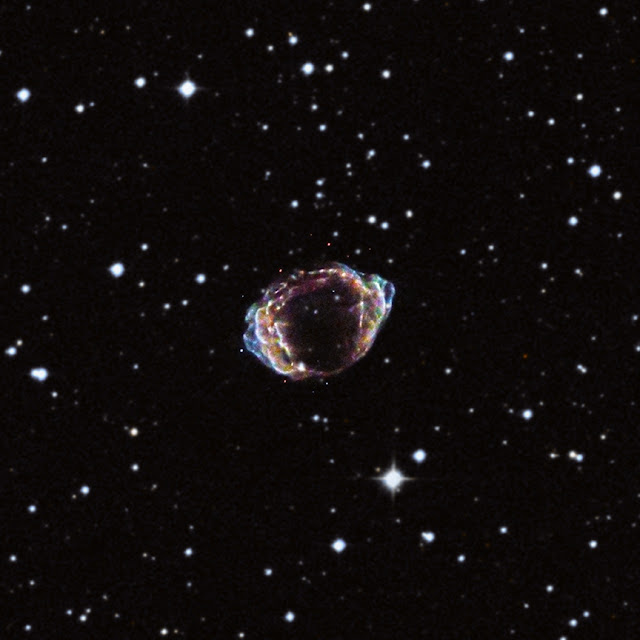We celebrated July 4th a week early
at the Chandra X-ray Center with this new image of cosmic fireworks. This is G1.9+0.3, the youngest remains - as seen from Earth - of any supernova in our galaxy. If gas and dust had not heavily obscured it, the supernova would have been visible from Earth just over a century ago.
Not all supernovas in our galaxy were hidden, depriving us of a free light show. Supernova 1006 was brighter than Venus and was visible
during the day for weeks in 1006 A.D. Here is a beautiful Chandra image,
released back in April, showing the remains of SN 1006.
Another supernova that was seen by early astronomers was Kepler's supernova, observed by Johannes Kepler in 1604. Here's what its remains look like now, in an image
released in March, 2013.
What do these 3 objects have in common, besides all being the photogenic remains of supernova explosions? All of them are likely caused by Type Ia supernovas, the thermonuclear explosion of a white dwarf. This distinguishes them from the other main class, a core-collapse supernova, where a massive star implodes.
There are many differences between these two types. One important difference is that a massive star self-destructs, but a white dwarf has to interact with another star to push it over a weight limit and explode, granting independence to about 6 million trillion trillion pounds of material. Without this interaction its mass would be locked up as it gradually cools down over countless billions of years.
When a core-collapse supernova occurs some material is locked up inside a newly-formed neutron star or a black hole. In Cassiopeia A the neutron star is clearly visible at the center of the supernova remnant.
Cas A is young enough, with an observed age of about 330 years, that expansion of the blast wave and debris is visible in a video showing Chandra images
obtained over 8 years.
Clearly our view of these cosmic fireworks is incomplete, but Chandra has only been observing since 1999.
The antithesis of cosmic independence occurs when a black hole forms, as may have occurred after the supernova that formed W49B. Here it's the
lack of evidence for a compact central object that helps make the case for a black hole, along with other features.
Finally, here's a completely different type of cosmic fireworks in the form of
planetary nebulas.
 |
| Four planetary nebulas seen with Chandra and HST. Credit: X-ray: NASA/CXC/RIT/J.Kastner et al.; Optical: NASA/STScI |
These objects are not as spectacular as supernovas in terms of the light and energy they produce, but they're just as beautiful. Because the Sun will evolve into a red giant and planetary nebula in about 5 billion years, Earth will inevitably become part of the show. Maybe by then humans will have travelled well away from the solar system so they can enjoy the stellar fireworks from a safe distance.








This comment has been removed by a blog administrator.
ReplyDelete